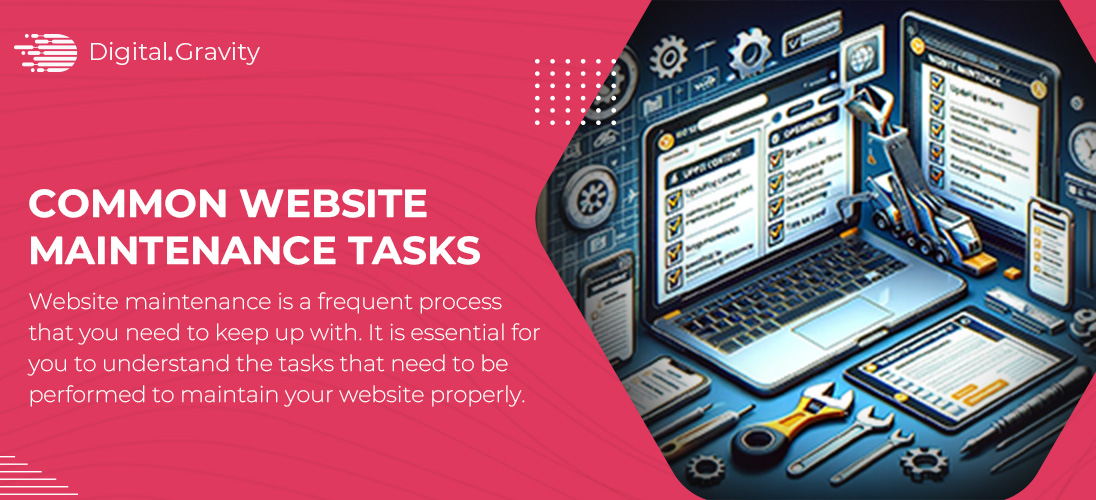As a website owner, your work doesn’t end once your website launches. Your website cannot perform on its own for attracting traffic forever. Like everything else, it also requires maintenance from time to time for you to achieve your goals.
Website maintenance is a frequent process and you need to keep up with it for your website to perform and provide you the desired results. To help you stay on top of your game, it is essential for you to understand the basics of website maintenance as well as the tasks or activities that need to be performed to manage them properly.
What is Website Maintenance?
Website maintenance is the process of improving your website for it to run smoothly, ensuring everything including broken links, content, speed, designs, backups, and other factors that contribute to performance, are absolutely perfect.
Website maintenance is more than finding errors in a website, it emphasizes the enhancement of user experience, security against potential cyber threats, and unlocking your website’s full potential to thrive. It is integral for your long-term success and enables you to avoid pitfalls for your business.
Common Website Maintenance Tasks That You Should Perform
1. Check Website Performance on Different Browsers
You never know what device or browser your users would opt for to visit your website. Therefore, you must make sure that they have no trouble accessing your website on any device.
Start by reviewing your site on different devices to ensure its smooth operation. Moreover, you need to focus on mobile-friendliness as well. The vast majority uses smartphone for browsing, hence, your site must be responsive, mobile-friendly and should fit all screen sizes.
With regular updates of browsers and plugins, you may face problems with functioning across different devices. So, check your website on tablets, smartphones, and laptops with different browsers on every device. You have to be completely sure that everything functions how it is supposed to.
2. Optimize Website Speed
Did you know that Yahoo reduced its page loading time and witnessed a traffic hike by 9%?
Yes, this is the impact of your website speed on web traffic and eventually on your website ranking. If you page is taking 10 or more seconds, your audience is likely going to give up on your site and lose attention. Therefore, you make every effort in your website maintenance services to reduce your page speed as low as possible.
You can use tools such as Google PageSpeed Insights to evaluate metrics that impact your site speed. You can also use techniques such as browser caching, image optimization and Gzip compression to further improve your website load time.
3. Check for Broken Links
Dead or bad links can harm the credibility of your website. This is the reason you need to check your links to ensure that they direct users to where they are meant to. Broken links annoy users because no one enjoys “404 error not found” landing on their page. These links ultimately leak your traffic.
Your website’s internal links must also be intact and perfectly functional. You must use effective tools such as Screaming Frog to identify the broken links after which you can remove or update them.
4. Check Your CTA’s
Your CTA (Call to Action) is supposed to encourage users to take the action that is your main goal i.e. making a purchase, reaching out to you etc.
As important as CTA’s are, their performance is equally important. You must test your CTA’s regularly and make sure they are working. Moreover, if you have an ecommerce business, your CTA’s should persuade your visitors to add items to the cart and make the purchase, and in such cases you can use CTA’s like “Buy Now” or “Check Out” button.
5. Track Website Analytics
Your website maintenance greatly reflects on your analytics to measure the success of your website. There are many robust tools to fulfill this purpose including Google Analytics which provides you in-depth analysis of the bounce rate, conversion rates, conversions, demographics, page views, page visits per day, and more.
You can analyze your audience’s behavior to understand their emotions and use this to your advantage by polishing your strategy and enhancing your user engagement. The updated content will help you improve the quality and quantity of your website.
How Frequent Do I Need Website Maintenance?
The frequency of your website maintenance depends on many factors including the size and the scope of your website. As a general idea, your website should be updated on a monthly basis, or more frequently if it’s possible.
Conclusion
Website maintenance is super important for your site to function accurately. It enables your site to look fresh, updated, and perform well. By ensuring every maintenance task is performed correctly, you can guarantee the efficiency and longevity of the site. These maintenance activities act as an investment that is immensely rewarding in the future.
A dynamic website maintenance service provider can elevate the standards of your business. Digital Gravity KSA is one such provider which takes the stress away of website maintenance from its clients and delivers exceptional results with their website maintenance services in Saudi Arabia which reflect in their clients’ site visibility and overall business growth.








